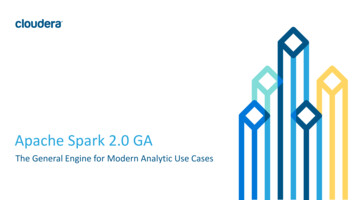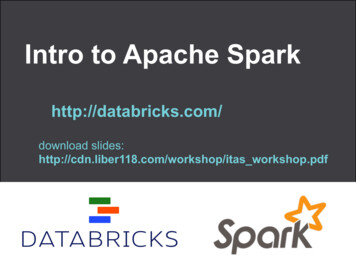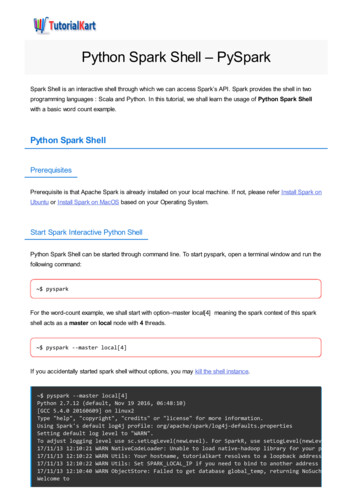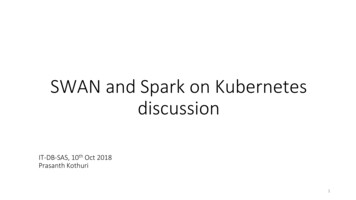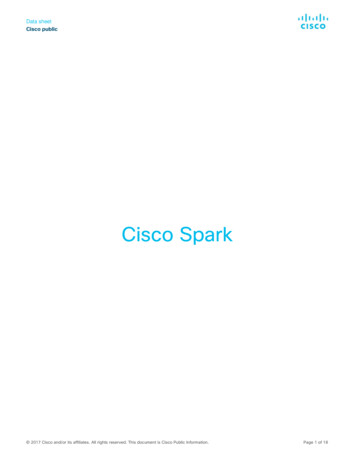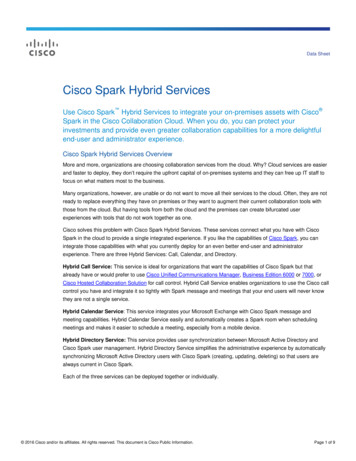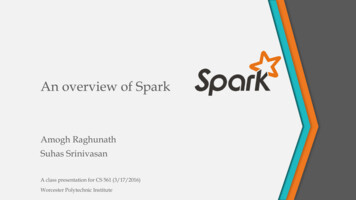
Transcription
An overview of SparkAmogh RaghunathSuhas SrinivasanA class presentation for CS 561 (3/17/2016)Worcester Polytechnic Institute
Outline1. Introduction2. Motivation3. Spark Programming Model4. Resilient Distributed Datasets5. Spark Programming Interface6. Representing Resilient Distributed Datasets7. Implementation8. Evaluation9. Conclusion
Introduction Apache Spark is an open source cluster computing framework. Originally developed at the University of California, Berkeley'sAMPLab by Matei Zaharia. Spark codebase was later donated to the Apache SoftwareFoundation that has maintained it since. Fast & general engine for big data processing. Generalizes MapReduce model to support more types ofprocessing.
Motivation MapReduce was great for batch processing, but users quicklyneeded to do more: More complex, multi-pass algorithms More interactive ad-hoc queries More real-time stream processing Result: many specialized systems for these workloads
Motivation
Motivation
Motivation Problems with Specialized Systems More systems to manage, tune and deploy. Can’t combine processing types in one application Even though many pipelines need to do this. e.g. load data with SQL, then run machine learning. In many pipelines, data exchange between engines is the dominantcost.
Motivation Recall 3 workloads were issues for MapReduce: More complex, multi-pass algorithms More interactive ad-hoc queries More real-time stream processing While these look different, all 3 need one thing that MapReducelacks: efficient data sharing
Motivation
Motivation
Motivation
Spark Programming Model1. Developers write a driver program that implements the high-levelcontrol flow of their application and launches various operationsin parallel.2. Spark provides two main abstractions for parallel programming:resilient distributed datasets and parallel operations on thesedatasets.3. Spark supports two restricted types of shared variables that canbe used in functions running on the cluster.
Spark Programming Model
Spark Programming Model A resilient distributed dataset (RDD) is a collection of objects thatcan be stored in memory or disk across a cluster. Built via parallel operations and are fault-tolerant withoutreplication.
Spark Programming ModelSeveral parallel operations can be performed on RDDs: reduce: Combines dataset elements using an associative function toproduce a result at the driver program. collect: Sends all elements of the dataset to the driver program. foreach: Passes each element through a user provided function.
Spark Programming ModelDevelopers can create two restricted types of shared variables tosupport two simple but common usage patterns: Broadcast variables: If a large read-only piece of data is used inmultiple parallel operations, it is preferable to distribute it to theworkers only once. Accumulators: These are variables that workers can only “add” tousing an associative operation, and that only the driver can read.Useful for parallel sums and are fault tolerant.
Spark Programming Model
Spark Programming Model
Resilient Distributed Datasets Existing abstractions for in-memory storage on clusters offer aninterface based on fine-grained updates. With this interface, the only ways to provide fault tolerance are toreplicate the data across machines or to log updates acrossmachines. Both approaches are expensive for data-intensive workloads, asthey require copying large amounts of data over the clusternetwork.
Resilient Distributed Datasets A resilient distributed dataset (RDD) is a read-only collection ofobjects partitioned across a set of machines that can be rebuilt if apartition is lost. The elements of an RDD need not exist in physical storage; instead,a handle to an RDD contains enough information to compute theRDD starting from data in reliable storage. Users can control two other aspects of RDDs: persistence andpartitioning. Users can indicate which RDDs they will reuse and choose astorage strategy for them (e.g., in-memory storage). They can also ask that an RDD be partitioned across machines thisis useful for placement optimizations.
Resilient Distributed Datasets
Resilient Distributed Datasets
Resilient Distributed DatasetsAdvantages Existing frameworks (like MapReduce) access the computationalpower of the cluster, but not distributed memory.- Time consuming and inefficient for applications that reuseintermediate results. RDDs allow in-memory storage of intermediate results, enablingefficient reuse of data.
Resilient Distributed DatasetsComparison of RDDs with distributed shared memory
Resilient Distributed DatasetsCreating RDDs Two methods:1. Loading an external dataset.2. Creating an RDD from an existing RDD.
Resilient Distributed Datasets1. Loading an external dataset Most common method for creating RDDs Data can be located in any storage system like HDFS, Hbase ,Cassandra etc. Example:lines spark.textFile("hdfs://.")
Resilient Distributed Datasets2. Creating an RDD from an Existing RDD An existing RDD can be used to create a new RDD. The Parent RDD remains intact and is not modified. The parent RDD can be used for further operations. Exampleerrors lines.filter( .startsWith("ERROR"))
Resilient Distributed DatasetsOperations Transformations and Actions are two main types of operations thatcan be performed on a RDD. Concept similar to MapReduce:- Transformations are like the map() function.- Actions are like the reduce() function.
Resilient Distributed DatasetsTransformations Operations on existing RDDs that can return a new RDD. Transformation examples: map, filter, join.- Example: running a filter on one RDD to produce another RDD.
Resilient Distributed DatasetsTransformationslines spark.textFile("hdfs://.")errors lines.filter( .startsWith("ERROR")) Original parent RDD is left intact and can be used in futuretransformations. No action takes place, just metadata of errors RDD are created.
Resilient Distributed DatasetsActions Perform a computation on existing RDDs producing a result. Result is either:- Returned to the Driver Program.- Stored in a files system (like HDFS). Examples:- count()- collect()- reduce()- save()
Resilient Distributed DatasetsFault Tolerance In event of node failure, operations can proceed. Spark uses an approach called the Lineage Graph or DirectedAcyclic Graph (DAG). Critical to maintain dependencies between RDDs. Linage Graph are maintained by the DAGScheduler.
Resilient Distributed DatasetsFault Tolerance Model that describes steps required and business logic needed tocreate the end result of the transformation process. Does not store the actual data. Example:
Resilient Distributed DatasetsLazy Evaluation Transformation operations in RDD are referred to as being lazy.- Results are not physically computed right away.- Metadata regarding the transformations is recorded.- Transformations are implemented only when an action is invoked. Example:lines spark.textFile("hdfs://.")errors lines.filter( .startsWith("ERROR"))- RDD errors are not returned to Driver program.- Instead, the transformations are implemented only when a action on errorsRDD is invoked ( like errors.persist() ).
Resilient Distributed DatasetsExample:lines spark.textFile("hdfs://.")errors lines.filter( .startsWith("ERROR"))errors.count()
Resilient Distributed DatasetsApplications not suited for RDDs RDDs are best suited for batch applications that apply the sameoperation to all elements of a dataset. Less suitable for applications that make asynchronous fine grainedupdates to shared state- Storage system for web application- Incremental Web crawler
Spark Programming Interface
Spark Programming InterfaceDriver Program Every spark application consists of a “driver program”.- Responsible for launching parallel tasks on various cluster nodes.- Encapsulates the main() function of the code.- Defines distributed datasets across the nodes.- Applies required operations across the distributed datasets.
Spark Programming InterfaceSparkContext (sc) Means of connecting the driver program to the cluster. Once SparkContext is ready, it can be used to built an RDD.
Spark Programming InterfaceExecuters Driver Program manages nodes called executers.- Used to run distributed operations.- Each executor performs part of operation. Example: running count() function- Different partition of the data sent to each executor.- Each executor counts the number of lines in its data partitiononly.
Representing Resilient Distributed Datasets RDDs are broken down into:- Partitions- Dependencies on parent RDDs How to represent dependencies between RDDs?- Narrow DependencyExample: Map- Wide DependencyExample : Join
Representing Resilient Distributed DatasetsNarrow Dependency All the partitions of the RDD will be consumed by a single childRDD. Example:- Filter- Map
Representing Resilient Distributed DatasetsWide Dependency Multiple child RDDs may depend on a parent RDD. Example:- Join- Group By
Representing Resilient Distributed DatasetsInterface used to represent RDD in Spark
ImplementationJob Scheduling When an action is invoked on an RDD, the scheduler checks thelineage graph to be executed.
ImplementationMemory ManagementThree options for storage of persistent RDDs:1. In-memory st2. In-memory storage as serialized data (Memory efficient but lowerperformance)3. On-disk storage (RDD is too large to fit in memory, highest cost)
ImplementationMemory Management LRU eviction policy at the level of RDDs is used. When a new RDD partition is computed but there is not enoughspace, a partition from the LRU RDD is evicted. Unless this is the same RDD as the one with the new partition keepthe old partition to prevent cycling partitions. Users get further control via a “persistence priority” for each RDD.
ImplementationCheckpointing Recovery may be time-consuming for RDDs with long lineagechains. Spark provides an API for checkpointing (a REPLICATE flag topersist). Automatic checkpointing – the scheduler knows the size of eachdataset and the time it took to first compute it, it should be able toselect an optimal set of RDDs to checkpoint to minimize recoverytime. Metadata can also be checkpointed to account for Driver nodefailure.
Evaluation Spark outperforms Hadoop by up to 20x in iterative machinelearning and graph applications. The speedup comes from avoiding I/O and deserialization costs bystoring data in memory as Java objects. When nodes fail, Spark can recover quickly by rebuilding only thelost RDD partitions. Spark can be used to query a 1 TB dataset interactively withlatencies of 5–7 seconds.
EvaluationDuration of the first and later iterations in Hadoop, HadoopBinMem and Spark for logisticregression and k-means using 100 GB of data on a 100-node cluster.
EvaluationRunning times for iterations after the first in Hadoop, HadoopBinMem, and Spark. Thejobs all processed 100 GB.
EvaluationHadoopBinMem ran slower due to several factors:1. Minimum overhead of the Hadoop software stack.2. Overhead of HDFS while serving data.3. Deserialization cost to convert binary records to usable inmemory Java objects.
EvaluationIteration times for logistic regression using 256 MB data on a single machine for differentsources of input.
EvaluationIteration times for k-means in presence of a failure. One machine was killed at the start ofthe 6th iteration, resulting in partial reconstruction of an RDD using lineage.
EvaluationPerformance of logistic regression using 100 GB data on 25 machines with varyingamounts of data in memory.
EvaluationResponse times for interactive queries on Spark, scanning increasingly larger inputdatasets on 100 machines. Querying the 1 TB file from disk took 170s.
Conclusion How should we design computing platforms for the new era ofmassively parallel clusters? As we saw the answer can, in many cases, be quite simple: a singleabstraction for computation, based on coarse-grained operationswith efficient data sharing, can achieve state-of-the-artperformance.
ConclusionLessons Learned The importance of data sharing. Value performance in a shared setting over single-application. Optimize the bottlenecks that matter. Simple designs compose.
ConclusionMost active open source project in big data processing.
Conclusion
Conclusion
References1. Matei Zaharia et al. “Spark: Cluster Computing with WorkingSets”.2. Matei Zaharia et al. “Resilient Distributed Datasets: A FaultTolerant Abstraction for In-Memory Cluster Computing”.3. Matei Zaharia’s dissertation, “An Architecture for Fast andGeneral Data Processing on Large Clusters”.4. Databricks resources (https://databricks.com/resources/slides).5. Apache Spark programming ingguide.html).
References6. Learning Spark – O’reilly7. espark/content/spark-sparkcontext.html8. -bebetter-than-mapreduce.html9. ncymassively-parallel.html10. ncymassively-parallel.html
Thank you!
Spark outperforms Hadoop by up to 20x in iterative machine learning and graph applications. The speedup comes from avoiding I/O and deserialization costs by storing data in memory as Java objects. When nodes fail, Spark can recover quickly by rebuilding only the lost RDD partitions.
